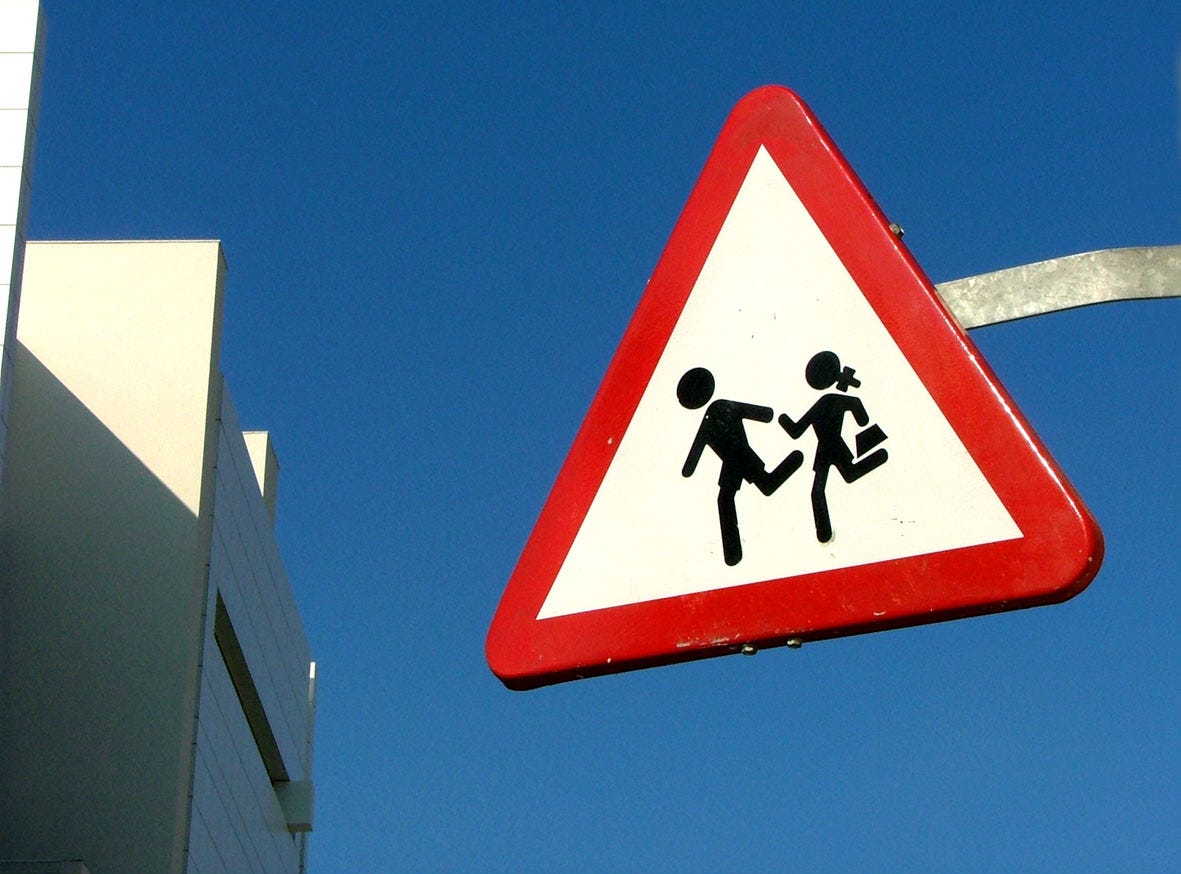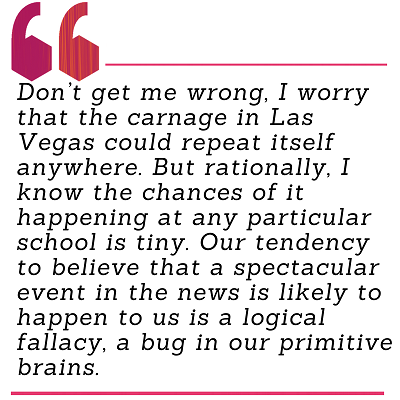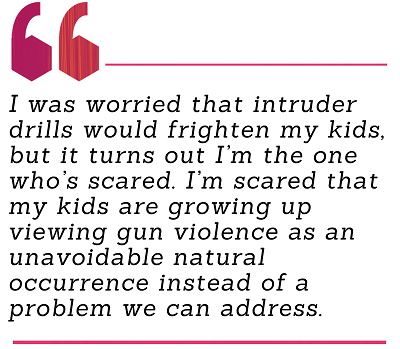
Opinion
Why School Shooter Drills Are Terrifying Nonsense
“Our tendency to believe that a spectacular event in the news is likely to happen to us is a bug in our primitive brains.”


Icry when I listen to the news. When I heard on the radio that 58 concertgoers were murdered in Las Vegas by a shooter in a hotel room last month, tears dripped into my kids’ lunch boxes as I packed them. With that many people killed, I imagined families grieving in all 50 states.
Five weeks later, the body count in the mass shooting in Sutherland Springs, Texas wasn’t what affected me (it was 26); it was that nearly a third were children. Then, a gunman in Tehama, California committed the kind of attack that frightens parents the most: after going on a shooting rampage across town, he attacked an elementary school. Even though, thank goodness, the shooter didn’t manage to get into the school, it brought back a flood of memories of what is, to me, the worst day in American history: Dec. 14, 2012.
Every time I hear about another massacre, I am transported back to that morning when 20 first-graders were slaughtered at Sandy Hook Elementary School in Newtown, Connecticut. On that day, my body felt chilled, then flushed, as if struggling for equilibrium. I wanted to run to my daughter’s kindergarten and carry her home to safety.
But I didn’t, because I understood that worrying a shooter would kick in the door was about as realistic as worrying a meteor would hit the roof.
My kids’ San Francisco-area elementary and middle schools are among the many that have added intruder drills in the wake of Sandy Hook and other mass shootings. 70 percent of public schools ran shooter drills as of the 2013–14 school year, compared to less than half a decade earlier, according to the National Center for Education Statistics.
So how grateful am I that my kids know what to do if a gunman enters their school?
I’m not. In fact, I wish our schools didn’t do intruder drills at all — they’re nothing but terrifying nonsense.
Don’t get me wrong, I worry that the carnage in Las Vegas could repeat itself anywhere. But rationally, I know the chances of it happening at any particular school is tiny. Our tendency to believe that a spectacular event in the news is likely to happen to us is a logical fallacy, a bug in our primitive brains.

Mass shootings in schools are, thankfully, still exceedingly rare. The crisis-preparedness organization Safe Havens International counted 50 student deaths due to “active shooter” incidents at schools between 1998 and 2012 — most of them from Sandy Hook and Columbine High School, where two students gunned down 12 of their classmates and a teacher in 1999. There are 56 million K-12 students in the United States. That gives each of my kids a 1 in 17 million chance of being killed by an active shooter at school this year. There’s a significantly higher chance of being killed by lightning (1 in 13 million) or a dog attack (1 in 9 million) in a given year.
During the same 15-year period, ten times as many people died in school bus accidents, according to Safe Havens International. The organization also counted more than twice as many suicides at schools during that period as mass shooting deaths — yet we don’t do suicide drills.
Thank goodness our schools aren’t among those using fake AR-15s and blood capsules. My kids just crouch under a red dot on the ceiling and elbow each other.

I don’t blame school administrators and parents for wanting to do something to protect our kids against gun violence. It is a monstrous problem that requires action. But teaching our kids to hide from a gunman isn’t doing something, it’s just adapting to it.
Just weeks prior to the horrific 2012 attack, Sandy Hook conducted a lockdown drill, in which children practiced hiding. Did it help? Perhaps. Press reports describe many survivors hiding in cabinets and under desks. Then again, most of the little victims were found crowded in a classroom bathroom, apparently trying to carry out the procedure they’d practiced.
So if intruder drills might help, isn’t it better to be safe than sorry?
A school in San Diego uses a “facility dog” to offer children a kind of healing that humans sometimes cannot provide.brightthemag.com
The simple answer is that it just doesn’t make sense when there are so many more probable dangers. My kids’ schools are near a 20-mile-deep fault line, which has a 72 percent chance of causing a major earthquake in the next 30 years. A gas leak could cause a massive explosion. Even that old bugaboo from the 1950s, the nuclear attack, is starting to feel like a real threat again. If we tried to address every danger our kids face, the entire school day would be devoted to disaster drills.
The more complicated answer is that drilling fear into kids about unlikely disasters might be worse than pointless.
“[A]rmed assailant drills not conducted appropriately may cause physical and psychological harm to students, staff, and the overall learning environment,” warned a 2014 joint report from the National Association of School Psycholog....
So far, my kids have shrugged off intruder drills with no signs of trauma. But I wonder about the long-term effects. When my mother had to crawl under her desk and cover her head with her hands in the 1950s and 1960s it instilled a dread of all things nuclear that lingers with Baby Boomers today. One child of the Cold War posited in Scientific American that this fear “framed the phobia about nuclear power, leading to a coal-based energy policy which has killed hundreds of thousands of people from air pollution and threatens the very climate on which life on earth depends.”
When I was a kid in the 1980s, we were taught to fear strangers. Teachers and police officers warned we could be kidnapped if we walked home from school alone, despite the fact that stranger abductions have always been rare — the Polly Klaas Foundation put the number at just 100 annually.
Is it any surprise that many of my fellow Generation X classmates grew up to be “helicopter parents,” the phenomenon blamed with creating young adults who can’t handle college or jobs ...?

I was worried that intruder drills would frighten my kids, but it turns out I’m the one who’s scared. I’m scared that my kids are growing up viewing gun violence as an unavoidable natural occurrence instead of a problem we can address.Already, our society reacts to gun violence by increasing security: adding metal detectors and cameras to public places and broadening concealed carry laws, supposedly to let citizens protect themselves. I would rather increase gun control, broaden access to mental healthcare, and increase research on what pushes people to go on shooting sprees.
The kids cowering under red dots across America are tomorrow’s senators, police chiefs, scout leaders, gun dealers, psychologists, mothers, and fathers. Is hiding the most important thing they need to know to address the gun violence they’re inheriting? I’d rather see them spend the time learning about problem solving, because on this particularly problem, their parents’ generation is failing spectacularly.
Gun violence is a threat to our nation more than it is to any kid’s individual classroom. The last thing any of us should be doing is hiding.

Please subscribe to BRIGHT Magazine’s weekly newsletter, and please follow us on Facebook and Twitter.
BRIGHT Magazine is made possible by funding from the Bill & Melinda Gates Foundation. BRIGHT retains editorial independence. The Creative Commons license applies only to the text of this article. All rights are reserved in the images. If you’d like to reproduce this on your site for noncommercial purposes, please contact us at hello@honeyguidemedia.org.
You need to be a member of School Leadership 2.0 to add comments!
Join School Leadership 2.0